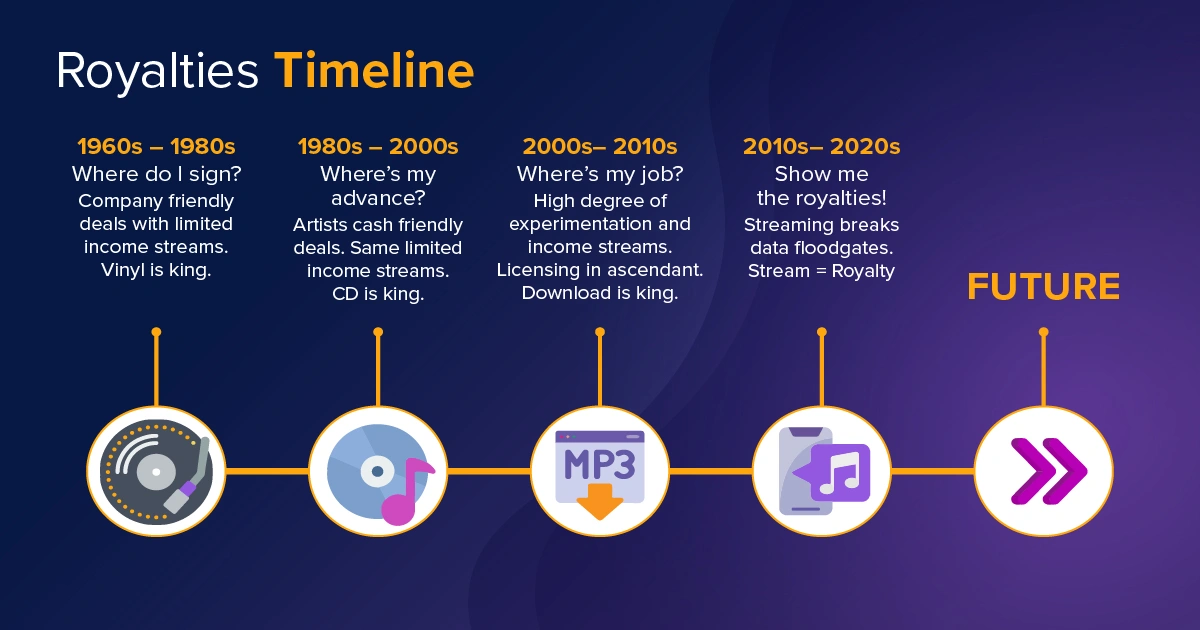
Understanding the complex music streaming royalty ecosystem ensures you get paid
Forget 6-month stress cycles and audit hell. Music royalties have become chic. The rise of streaming has ignited a data and transparency revolution, shaking up not only how artists, songwriters and the entire industry get paid but also democratizing a once opaque world for the benefit of shareholders and the public at large so that anyone can participate in the royalties boom.
A tangled web
Royalties are the lifeblood of the music industry, serving as the primary source of income for artists, songwriters, music publishers and record labels. However, beware:
From vinyl vaults to virtual streams
The journey from manual ledgers to data deluge is fascinating.
1960s — The dream business
Royalties were often considered an afterthought by artists and songwriters, managed with handshakes and good — or bad — faith. Disputes were rife as transparency was nonexistent and royalty processing was done manually.
1980s — Computerization era
Labels embraced the automation of royalties processes. Audits became routine for royalty managers — particularly for artists that had been burned in the 60s and 70s — yet huge advances were the name of the game for new artists and their managers, with royalties and recoupment taking a back seat. This dynamic often obscured financial realities.
2000s — Freefall and consolidation
Music company consolidation reshaped the landscape and iTunes consolidated access to downloads. This was a time of much experimentation with various DIY and payment models.
2010s — Show me the royalties
Billions of streams overwhelmed systems, exposing a value gap favoring major players. Indie artists faced new gatekeepers and mistrust simmered as advances dwindled and royalty complexities remained daunting. Nevertheless, we entered a boom time!
Reshaping royalties
The rise of streaming has done more than change how we listen to music; it's sparked a revolution in the world of music royalties. There are now many companies and initiatives looking to optimize royalties in 4 main areas:
- Transparency
- Complexity
- Inaccuracy
- Frequency
Transparency — Why and how do I get paid?
Artist portals, richer data from DSPs, and agencies like the Mechanical Licensing Collective are shedding light on royalty statements. Blockchain solutions have promised an ever-evolving record of ownership and payouts.
Complexity — How do I get paid?
New aggregators simplify the process for creators, while specialized players tackle the complexities of neighboring rights. Back-office systems further streamline royalty administration.
Inaccuracy — What am I getting paid?
Digital music management platforms track rights and ensure data integrity, while other technology companies hunt down unclaimed royalties. Music credits database companies fix credit attribution, and royalty accounting software and service companies offer outsourcing for those overwhelmed by the details.
Frequency — When do I get paid?
The timing of royalty payments can vary significantly, creating cash flow challenges for artists who rely on these earnings as their primary source of income. Irregular payments make it difficult for artists to plan for the future and invest in their creative endeavors.
Digital music royalty collection companies harness big data to accelerate collection, and music distribution and payment platforms simplify accounting for artists and labels. Advance financing services empower creators to tap into their future earnings.
Platforms allow fans and investors to directly invest in artists, bridging the gap between creators and their most valuable supporters.
Soundtrack of the future
Increased transparency into royalty statements, streamlined royalties processes and new funding models pave the way for a more equitable and sustainable future for creators and rightsholders alike. How’s that for chic? This is just the beginning and the soundtrack of the future promises to be filled with exciting new possibilities.
Get the latest news, updates, and exclusive insights from Vistex delivered straight to your inbox. Don’t miss out—opt in now and be the first to know!


